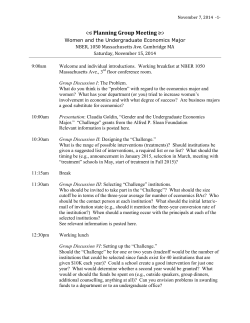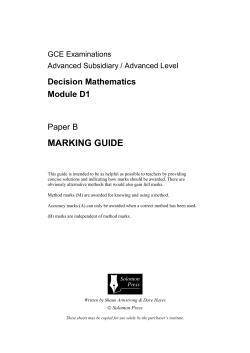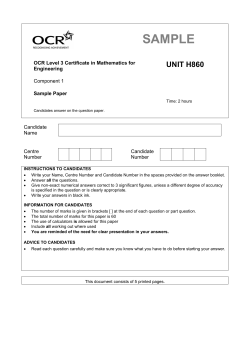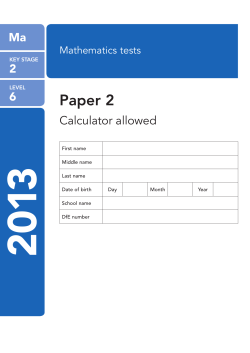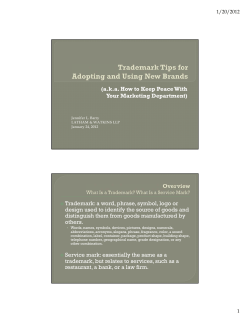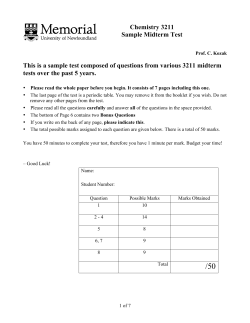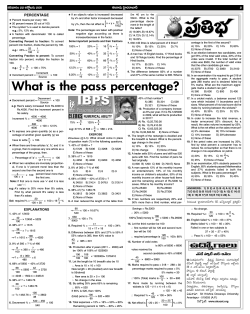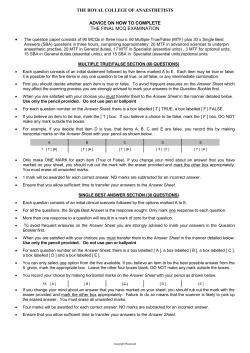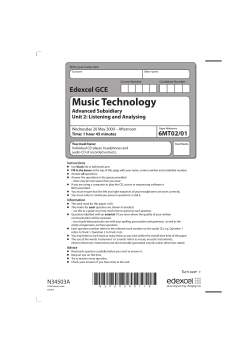
Document 255165
UNIVERSITY OF ESSEX DEPARTMENT OF ECONOMICS ASSESSED WORK COVER SHEET Module code and title:.........................…………………...................………………………... Family Name: ….………..............…...….......…..Given Names:………………...….......…................. (BLOCK CAPITALS) (BLOCK CAPITALS) Registration number: ……………………… Please read the following carefully: In signing this cover sheet you confirm: 1. That the attached work complies with University regulations governing academic offences, in particular regulations 6.20 and 6.21. Please follow the link, Information and Publications, from the University’s website, to University Regulations, Policy and Procedures, to Academic Offences Procedures. 2. That you are aware of the guidelines set out in the Undergraduate/Postgraduate Economics Handbook (as appropriate), and in particular that: (a) You have read and understood A Guide to Good Practice in Assessed Work in the Undergraduate/Postgraduate Economics Handbook. (b) All material copied from any other source is referenced in accordance with the guidelines set out in the Undergraduate/Postgraduate Economics Handbook. (c) You have acknowledged the assistance of other people who have contributed substantively to your submitted work. (d) You have acknowledged any overlap between the present submission and other assessed work either at the University of Essex or elsewhere. 3. That you are aware of the University of Essex Code of Practice on intellectual property rights (see the Undergraduate or Postgraduate Economics Handbook or the University website. Go to Information and Publications, from the University’s website, to University Regulations, Policy and Procedures and then to Regulations relating to Academic Affairs. The following statement must be signed: I confirm that I take personal responsibility for complying with the University regulations governing academic offences and that I consent for my submission to be processed in the context of the JISC Plagiarism Detection Service. Signed: .......…................……………............................. Date: …………............... If you have worked closely with another student or sought advice from a proof reader in the preparation of this assessed work please ask that person to complete the section below: Signed: .......…................……………............................. Date: …………............... A copy of this sheet must be attached to each Term Paper, Assignment, Project or Dissertation submitted in the Department of Economics. UNIVERSITY OF ESSEX SPRING TERM 2014 DEPARTMENT OF ECONOMICS EC111 – INRODUCTION TO ECONOMICS ASSIGNMENT 2 This assignment is to be handed in to Room 5B.209 before 12 noon on Monday 3rd March 2014. You will receive and electronic receipt. You should not hand in assignments to your class teacher. Please note that the University has a zero tolerance policy on late submission of coursework. Any assignment submitted after the deadline will receive a mark of zero (see Undergraduate Economics Handbook). Please make sure that your NAME and the name of your CLASS TEACHER are printed clearly on the front page of your assignment. This assignment is divided into two sections. Each is worth 50 percent of the marks. You should answer all the questions. Use diagrams or mathematical expressions where appropriate. Please limit your answers to a total length of not more than 5000 words or 10 pages including diagrams. YOUR NAME:……………………………………………………………………… (Block capitals only) CLASS NUMBER:………………………………………………………………… CLASS TEACHER’S NAME:……………………………………………………… (Block capitals only) SECTION A (10 questions, 5 marks each) State whether each statement is TRUE or FALSE giving a brief explanation in the space provided. Use diagrams where appropriate. Your mark will depend on your explanation e.g. even if the statement is correct, putting “TRUE” will get no marks unless you justify your answer. 1. A direct tax is a tax paid on consumption goods. 2. An increase in the marginal propensity to save increases the value of the Keynesian multiplier. 3. If the government increases its expenditure and its (lump sum) direct tax by the same amount, there will be no increase in national income. 4. An increase in the interest rate reduces the present value of an investment project by more the further in the future are the revenues from the investment. 5. In an IS/LM economy an increase in the indirect tax rate will reduce investment. 6. If the central bank raises the reserve requirements of the banking system the money supply will fall. 7. An increase in national income, with a constant money supply, will reduce the price of bonds. 8. If labour supply and labour demand are equal, there will be job vacancies but no unemployment. 9. In the long run there is no trade-off between inflation and unemployment. 10. If the unemployment rate is higher than the Non-Accelerating Inflation Rate of Unemployment (NAIRU) the price level must be falling. SECTION B (2 questions, 25 marks each) 1. A closed economy with a fixed price level has the following relationships: Consumption: C = 50 + 0.8Yd, Investment: I = 150 – 10r Government expenditure: G = 250 Direct tax: Td = 0.25Y Real money demand: MD/P = 0.5Y – 20r Money supply MS = 400 Y is national income; Yd is disposable income and r is the interest rate. The price level, P, is fixed at P = 1. a) [7 marks] Find equilibrium national income. b) [6 marks] Now the consumption function shifts down to become: C = 0.8Yd. Suppose that in order to maintain the original income level government could either increase government expenditure or cut the tax rate. Find the necessary level of government spending or tax rate. Which of these policies would be preferred and why? c) [6 marks] With the consumption function as in (b) above, in the absence of fiscal policy, would monetary policy be an effective alternative? By how much should the money supply be increased? d) [6 marks] Now suppose that wages and prices were perfectly flexible and full employment national income is Y = 1000. With the money supply at the original level, MS = 400, what is the effect of the downward shift in the consumption function on investment and the interest rate? Compare this outcome with (c ) above and explain. 2. Use economic analysis to answer the following questions with reference to the British economy in the global financial crisis (GFC) and its aftermath. a. [5 marks] What caused the GFC and how would you expect it to have affected the money multiplier during and immediately after the crisis? b. [5 marks] Comment on the Bank of England’s response in the first two years after the crisis. What is meant by the ‘zero bound’ for interest rates? Does it mean that there is no further scope for monetary policy to stimulate the economy? c. [5 marks] Using IS/LM analysis show in a diagram what reaching the zero lower bound for the interest rate implies about the effectiveness of fiscal policy. d. [5marks] The government’s budget deficit rose substantially during the recession. How would you identify how much of that increase was due to fiscal stimulus and how much was due to the recession itself? e. [5 marks] Most observers believe that the fiscal multiplier is low--less than 2, and possibly around 1. Examine possible reasons for the low multiplier.
© Copyright 2025

